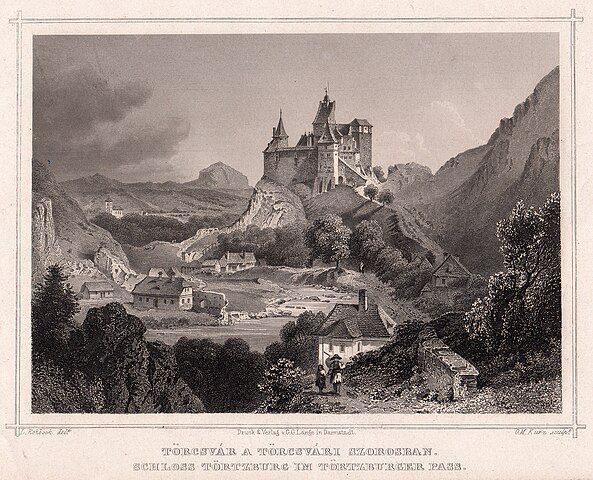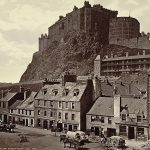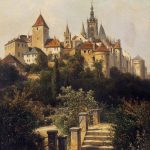
Bran Castle stands as one of Romania’s most fascinating historical landmarks. Located near the city of Brașov, the castle is often linked with the Dracula legend. This connection has helped make it one of the most popular tourist destinations in Eastern Europe. However, Bran Castle offers more than just spooky stories. Its stunning architecture and rich history attract many visitors. The castle’s Gothic and Renaissance elements reflect the architectural styles that influenced its design. This article explores the unique architectural features of Bran Castle. It also examines its artistic significance and its link to the Dracula legend.
Historical Background
Bran Castle’s origins trace back to the 14th century. In 1377, the Saxons of Kronstadt received permission from King Louis I of Hungary to build a stone fortress. Its construction was intended to protect the region from invaders. The location of the castle on a hilltop provided a strategic advantage. This position allowed defenders to spot approaching enemies from afar. Its initial purpose was purely defensive, reflecting the turbulent times.
During its early years, Bran Castle played a crucial role in the region’s defense. It served as a military outpost and customs post on the mountain pass between Transylvania and Wallachia. The castle’s strategic position helped control trade routes and protect against attacks. Over the centuries, Bran Castle evolved from a military fortification into a royal residence. It became a symbol of power and protection in the region.
Throughout its history, Bran Castle has been associated with several important figures. One of the most notable is Vlad the Impaler, who inspired the Dracula legend. Though there is little evidence that Vlad actually lived there, the association remains strong. In the 1920s, Bran Castle became a royal residence for Queen Marie of Romania. She transformed it into a summer palace, adding modern conveniences while preserving its historical charm.
Today, Bran Castle stands as a testament to Romania’s rich history. It has survived wars, changes in ownership, and the test of time. The castle’s transformation from a military fortress to a royal residence reflects its adaptability and resilience. Its unique architectural features make it a valuable cultural landmark in Romania.
Exterior Architectural Features
Bran Castle’s exterior showcases a blend of Gothic and Renaissance architectural styles. The castle’s design reflects its medieval origins, with imposing stone walls and fortified towers. The steep, red-tiled roofs add a distinctive touch to its silhouette. These architectural elements contribute to the castle’s imposing appearance. The exterior features are not only aesthetically pleasing but also served defensive purposes.
The castle’s defensive architecture includes several features designed to protect against invaders. The fortified towers, thick walls, and narrow windows were built to withstand attacks. The towers provided a vantage point for archers to defend the castle from approaching enemies. The walls were constructed to be strong and durable, offering protection to the inhabitants inside. The narrow windows allowed defenders to shoot arrows while minimizing the risk of incoming attacks.
Bran Castle’s strategic location on a hilltop adds to its defensive advantage. The elevated position allowed defenders to spot approaching threats from a distance. The surrounding landscape also provided natural barriers against invaders. The steep cliffs and dense forests made it difficult for enemies to reach the castle. This strategic location played a significant role in the castle’s effectiveness as a defensive stronghold.
The castle’s exterior also includes artistic elements that add to its charm. Decorative stonework and intricate carvings adorn the façade. These artistic details reflect the influence of regional craftsmanship. The blend of functional and artistic features gives Bran Castle its unique character. Its exterior remains a testament to the architectural skills of its builders.
Interior Architectural and Artistic Features
Bran Castle’s interior showcases a unique blend of architectural styles and artistic elements. The castle’s layout features a series of interconnected rooms and narrow corridors. The winding staircases and hidden passages add to the castle’s mystique. These architectural features reflect the castle’s medieval origins and royal transformations. The interior design provides insight into the lives of its historical inhabitants.
The castle’s interior design includes a variety of key rooms, each with its own unique features. The Great Hall is one of the most impressive rooms in the castle. It features high ceilings, large windows, and decorative stonework. The hall was used for gatherings and important events. The Queen’s Chamber is another notable room, with its elegant furnishings and artistic décor. These rooms reflect the castle’s transformation from a military fortress to a royal residence.
Bran Castle is home to a collection of artistic and decorative elements. The castle’s art collection includes paintings, sculptures, and antique furnishings. The influence of Gothic and Baroque art is evident in the interior décor. Intricate wood carvings and ornate details add to the castle’s aesthetic appeal. These artistic elements enhance the castle’s historical and cultural significance.
One of the most intriguing aspects of Bran Castle is its hidden passages and secret rooms. These concealed architectural features add to the castle’s allure. Secret passages were used for security and escape during times of conflict. The hidden rooms and corridors create a sense of mystery and adventure. These features continue to fascinate visitors and contribute to the castle’s legendary status.
Dracula Legend and Its Artistic Influence
Bran Castle is famously associated with the Dracula legend. This connection has made it one of Romania’s most popular tourist attractions. The legend of Dracula is based on the fictional character created by Bram Stoker. Stoker’s novel, published in 1897, introduced readers to the infamous vampire. Although Bran Castle is often linked to Dracula, the connection is more symbolic than historical.
The Dracula legend has significantly influenced artistic interpretations of Bran Castle. Artists and filmmakers have been inspired by the castle’s Gothic architecture and mysterious aura. Bran Castle has been depicted in various Dracula-themed movies, books, and artworks. These artistic representations contribute to the castle’s allure and mystique. The connection to Dracula adds a layer of intrigue and fantasy to the castle’s history.
The character of Dracula was inspired by Vlad the Impaler, a 15th-century ruler of Wallachia. Vlad was known for his brutal methods of punishment, which earned him a fearsome reputation. Although Vlad’s connection to Bran Castle is tenuous, the association persists. The Dracula legend has helped to popularize the castle and attract visitors from around the world. This association has become an integral part of the castle’s identity.
The Gothic architecture of Bran Castle plays a significant role in the Dracula legend. The castle’s imposing structure and dark, mysterious features align with the themes of the novel. The elements of Gothic architecture, such as pointed arches and dramatic towers, enhance the castle’s eerie atmosphere. These architectural features contribute to the perception of Bran Castle as Dracula’s home. The legend continues to captivate audiences and draw visitors to the castle.
Restoration and Preservation
Efforts to restore and preserve Bran Castle have been ongoing for many years. The goal of these projects is to maintain the castle’s historical and architectural integrity. Restoration efforts have focused on repairing and preserving the castle’s structural elements. This includes reinforcing walls, repairing roofs, and restoring original architectural features. These efforts ensure that the castle remains a valuable cultural and historical landmark.
Preservation projects have also focused on maintaining the castle’s interior design and artistic elements. This includes restoring paintings, sculptures, and antique furnishings. The goal is to preserve the artistic heritage of the castle and ensure that future generations can appreciate its beauty. Restoration efforts aim to balance historical accuracy with the need for modern enhancements. These projects help protect the castle’s unique character and historical significance.
Modern enhancements have been made to improve the visitor experience at Bran Castle. These include the installation of lighting, signage, and safety features. These improvements enhance accessibility and ensure that visitors can explore the castle safely. Modern technology has also been used to create interactive exhibits and displays. These features provide visitors with a deeper understanding of the castle’s history and significance.
Preservation efforts at Bran Castle face several challenges. The castle’s age and location pose difficulties for restoration projects. The harsh weather conditions in the region can affect the castle’s structural integrity. Additionally, the high volume of visitors can cause wear and tear on the castle’s features. Despite these challenges, ongoing restoration efforts continue to protect and preserve Bran Castle for future generations.
Bran Castle’s Influence on Art and Architecture
Bran Castle has had a significant impact on Romanian art and architecture. Its unique blend of Gothic and Renaissance styles has influenced local architectural designs. The castle’s imposing structure and artistic elements have inspired architects and artists alike. Bran Castle’s architectural features are often compared to other historical landmarks in Romania. Its influence can be seen in the design of churches, castles, and public buildings.
Artists have been inspired by Bran Castle’s architecture and its connection to the Dracula legend. The castle has been depicted in various paintings, photographs, and films. These artistic works often emphasize the castle’s dramatic and mysterious features. The influence of Bran Castle extends beyond Romania, inspiring artists and architects around the world. Its iconic status continues to captivate audiences and fuel creative expression.
Bran Castle has played a role in popularizing the Gothic Revival architectural movement. The castle’s Gothic elements, such as pointed arches and dramatic towers, align with the themes of the movement. These architectural features have been incorporated into modern designs, reflecting the enduring appeal of Gothic architecture. Bran Castle’s influence on the Gothic Revival movement has contributed to its status as an architectural icon.
The artistic and architectural significance of Bran Castle has made it a symbol of Romania’s cultural heritage. Its unique features and historical importance attract visitors and artists from around the world. Bran Castle continues to inspire creativity and innovation in the fields of art and architecture. Its enduring influence is a testament to the power of historical landmarks to shape cultural identity and artistic expression.
Myths and Legends in Architectural Context
Bran Castle’s architectural features have played a role in shaping its myths and legends. The castle’s imposing structure and dramatic elements contribute to its mysterious aura. These features have inspired countless tales of supernatural occurrences and ghostly apparitions. The myths and legends surrounding Bran Castle add to its allure and intrigue. The architectural context of these stories enhances the castle’s legendary status.
One of the most famous legends associated with Bran Castle is the Dracula myth. The castle’s Gothic architecture and strategic location have fueled the belief that it was Dracula’s home. This legend has captured the imagination of visitors and artists alike. The Dracula myth has become an integral part of the castle’s identity, attracting tourists from around the world. The architectural elements of Bran Castle play a crucial role in sustaining this legend.
Other myths and legends associated with Bran Castle include tales of hidden treasures and secret passages. The castle’s concealed architectural features have inspired stories of mystery and adventure. These legends add to the castle’s mystique and captivate the imagination of visitors. The combination of architectural elements and mythical tales creates a unique and enchanting experience. These stories continue to draw people to the castle, eager to explore its secrets.
The influence of myths and legends on Bran Castle’s architecture extends beyond its walls. The stories associated with the castle have inspired artistic interpretations and cultural representations. Artists have depicted Bran Castle in various forms, from paintings to films, capturing its mysterious essence. The architectural features of the castle have been incorporated into these works, enhancing their appeal. The interplay between myths, legends, and architecture creates a rich and fascinating narrative.
Conclusion
Bran Castle stands as a remarkable architectural and artistic landmark in Romania. Its unique blend of Gothic and Renaissance styles reflects its rich history and cultural significance. The castle’s architectural features and artistic elements continue to inspire creativity and innovation. Bran Castle’s association with the Dracula legend adds a layer of intrigue and mystery. The ongoing restoration efforts ensure that this iconic landmark remains a valuable cultural treasure. As Bran Castle continues to captivate audiences, it serves as a testament to the enduring power of architecture and art. Its legacy will undoubtedly inspire future generations.
Famous writer and historian John Julius Norwich once said, “Architecture is the art which so disposes and adorns the edifices raised by man for whatsoever uses, that the sight of them may contribute to his mental health, power, and pleasure.” Bran Castle, with its unique blend of history, architecture, and legend, exemplifies this sentiment. It stands as a symbol of Romania’s rich cultural heritage and its lasting impact on art and architecture.




